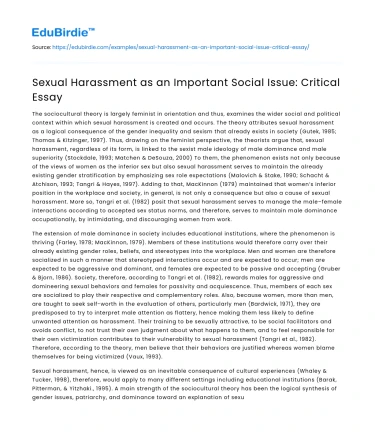The sociocultural theory is largely feminist in orientation and thus, examines the wider social and political context within which sexual harassment is created and occurs. The theory attributes sexual harassment as a logical consequence of the gender inequality and sexism that already exists in society (Gutek, 1985; Thomas & Kitzinger, 1997). Thus, drawing on the feminist perspective, the theorists argue that, sexual harassment, regardless of its form, is linked to the sexist male ideology of male dominance and male superiority (Stockdale, 1993; Matchen & DeSouza, 2000) To them, the phenomenon exists not only because of the views of women as the inferior sex but also sexual harassment serves to maintain the already existing gender stratification by emphasizing sex role expectations (Malovich & Stake, 1990; Schacht & Atchison, 1993; Tangri & Hayes, 1997). Adding to that, MacKinnon (1979) maintained that women’s inferior position in the workplace and society, in general, is not only a consequence but also a cause of sexual harassment. More so, Tangri et al. (1982) posit that sexual harassment serves to manage the male–female interactions according to accepted sex status norms, and therefore, serves to maintain male dominance occupationally, by intimidating, and discouraging women from work.
The extension of male dominance in society includes educational institutions, where the phenomenon is thriving (Farley, 1978; MacKinnon, 1979). Members of these institutions would therefore carry over their already existing gender roles, beliefs, and stereotypes into the workplace. Men and women are therefore socialized in such a manner that stereotyped interactions occur and are expected to occur; men are expected to be aggressive and dominant, and females are expected to be passive and accepting (Gruber & Bjorn, 1986). Society, therefore, according to Tangri et al. (1982), rewards males for aggressive and domineering sexual behaviors and females for passivity and acquiescence. Thus, members of each sex are socialized to play their respective and complementary roles. Also, because women, more than men, are taught to seek self-worth in the evaluation of others, particularly men (Bardwick, 1971), they are predisposed to try to interpret male attention as flattery, hence making them less likely to define unwanted attention as harassment. Their training to be sexually attractive, to be social facilitators and avoids conflict, to not trust their own judgment about what happens to them, and to feel responsible for their own victimization contributes to their vulnerability to sexual harassment (Tangri et al., 1982). Therefore, according to the theory, men believe that their behaviors are justified whereas women blame themselves for being victimized (Vaux, 1993).
Save your time!
We can take care of your essay
- Proper editing and formatting
- Free revision, title page, and bibliography
- Flexible prices and money-back guarantee
Sexual harassment, hence, is viewed as an inevitable consequence of cultural experiences (Whaley & Tucker, 1998), therefore, would apply to many different settings including educational institutions (Barak, Pitterman, & Yitzhaki., 1995). A main strength of the sociocultural theory has been the logical synthesis of gender issues, patriarchy, and dominance toward an explanation of sexual harassment. Furthermore, feminists’ focus on gender inequality in the workplace has often been credited with bringing the issue of sexual harassment to light (Thomas & Kitzinger, 1997); thus, opening up new avenues of inquiry for researchers in other areas such as the lecturer-student relationship within the educational institutions. Moreover, there does appear to be some supporting evidence for feminist sociocultural explanations of sexual harassment. For example, prevalence studies show that the majority of perpetrators are male, and other studies also show that harassment is more predominant in male-dominated workforces (Tangri et al., 1982; LaFontaine & Tredeau, 1986; Niebuhr & Boyles, 1991; Gruber, 1992; Brown, 1998; European Commission, 1998). The approach of sociocultural explanations of sexual harassment, however, appears to be over-inclusive and simplistic, that is, a lack of explanatory depth. Gender role socialization has evolved and expanded over time, to include more behaviors than the stereotyped expected gender behaviors, thus permitting more infusions of different behaviors to be accepted as normal for each gender (Bem, 1983). This, however, has not been accompanied by any measurable decrease in the phenomenon of sexual harassment. In addition, even though sexual harassment is a frequent phenomenon in society, it is not a normative behavior for men. Most men do not sexually harass, and the predominant nature of the feminist sociocultural theory does not provide a sufficient explanation as to why this is the case. Hence, the theory lacks internal coherence and empirical adequacy. Nevertheless, in the face of these drawbacks, the sociocultural theory helps to explain the phenomenon of sexual harassment from a broader and cultural point of view.






 Stuck on your essay?
Stuck on your essay?

